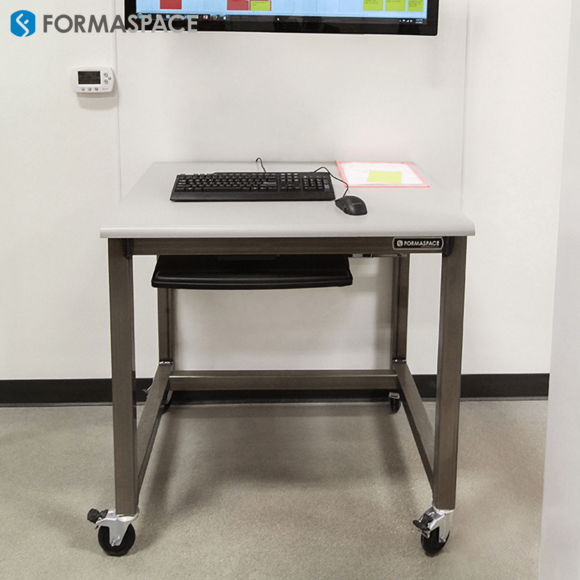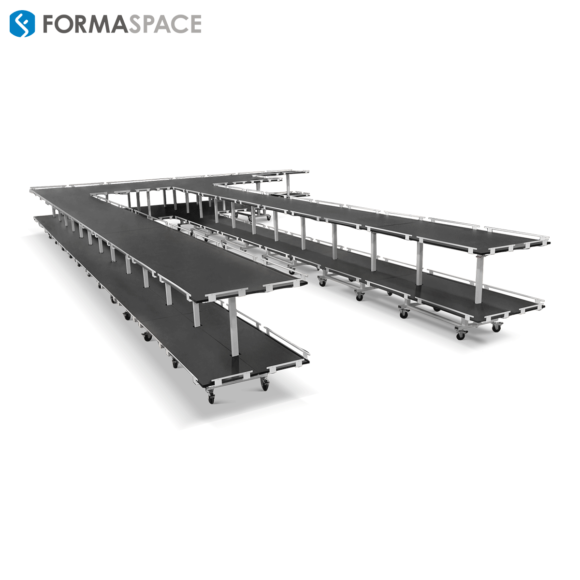Robot System Adoption Has Grown Rapidly Throughout the Pandemic
The pandemic changed the economic rules in many industries, and manufacturing is no exception.
· Increased Investment in Robot Technology across the Board
Like their counterparts around the world, many US manufacturers are making major investments in robot technology.
Capital expenditures are flowing for a couple of reasons.
First, many US manufacturers have been frustrated by the continued supply chain challenges that first arose during the Covid pandemic and, in response, have chosen to re-shore a growing number of manufacturing operations back to the US.
Second, investments in robot-based systems are a hedge against the current shortage in available workers.
Third, robot manufacturing operations offer a means to reduce the overall labor cost burden in US factories, allowing them to better compete with low-cost overseas production, particularly in southeast Asia.

New robotic welders have joined the production line team at Formaspace’s factory headquarters in Austin, Texas.
· Robotics Vendors are Not Just Paying Lip Service to Interoperability
Another factor that may be fueling the robotic capital investment boom is a shift away from relying exclusively on vendors offering end-to-end solutions. Instead, many of today’s manufacturing companies are seeking to implement sophisticated custom workflows that meet their unique requirements – and to achieve this typically requires greater interoperability between different best-in-class vendors. The emergence of open standards (such as those from the MassRobotics Autonomous Mobile Robots Interoperability Working Group) could help accelerate this trend further, leading to even higher adoption rates and greater productivity without being locked into a single vendor.
Formaspace Contract – Custom is the New Standard from FORMASPACE on Vimeo.
ERP Data Integration is now a Major Driver of Robotic System Implementations
· Rapid Growth of Robot Process Automation (RPA)
When we think about robots in manufacturing, what often comes to mind first are large-scale robots busy welding car bodies on the factory floor. And it’s true, welding robots certainly have their place (as we’ll see later), but the reality on the ground is quite a bit broader than that. It turns out that one of the fastest-growing segments for manufacturing robots is the Robot Process Automation (RPA) sector, which helps manage the overall orchestration of supply chain, logistics, material handling, distribution, picking/packing, distribution, and returns processing. Perhaps the easiest way to think about the role of RPA is to consider it the eyes and ears of corporate Enterprise Resource Process (ERP) platforms, collecting data at every stage of the production process – in many cases, even after products reach the hands of end-users.
· Big Data Collection / AI-ML Integration
Only connect!
— E.M. Forster in Howards End
Robots have transmogrified E.M. Forster’s declaration “Only Connect” into a new objective: “Only Collect.” Indeed, today’s robot-connected sensors (distributed throughout the supply chain, factory floor production line, warehouses, and distribution centers) are busy collecting unfathomable amounts of useful data – potentially leading us into the world of petabyte, exabyte, zettabyte, yottabyte, and brontobyte storage. This Big Data collection approach helps feed the appetites of machine-learning artificial intelligence algorithms to devour ever larger data sets – making them become “smarter” at providing useful, actionable insights to improve productivity and efficiency throughout the manufacturing ecosystem.
· Network and Data Security Issues Remain a Challenge
If there is a downside to the burgeoning growth of widespread distributed data collection (other than the cost of managing and maintaining mountains of data), it’s the increased risk that hackers can breach into networks to steal or attack sensitive manufacturing data, including proprietary corporate secrets. The enthusiasm for opening up an ever-broader array of IoT sensors and wireless networks (5G and soon 6G) must be tempered with the need for increased vigilance to protect the data from bad actor intruders.

Robot Technology Keeps Becoming More Sophisticated, Leading to new Industrial Applications
· Super Human Sensor Capability
Just as smartphone cameras have become more sophisticated, with higher resolutions and advanced features such as 3D image capture, so too have industrial robots used in manufacturing. Depending on the application required, manufacturing robots can be equipped with exceptionally high-resolution cameras, range detectors that measure distances/gaps (via Light Detection and Ranging or LIDAR for short), heat sensors, sensitive microphones, and more. Long gone are the days of primitive robot vision systems, where a robot hand had difficulty differentiating a box from a ball. Today’s systems are tied into sophisticated AI/ML-powered logic tools, giving manufacturing robots almost superhuman capabilities to sense items and interpret what to do with them.
· “Don’t Squeeze the Charmin” – Enhanced Robot Touch
Robot technology has also greatly advanced in its ability to manipulate objects quickly, accurately, and without damaging them, allowing them to handle delicate objects without “squeezing the Charmin.” In some cases, humans remain in charge of controlling the robot’s ability to grip, twist, pull, and push – a process that’s made easier by a “haptic feedback” system that gives the human operator a realistic “feel” for what the robot is doing – even if it’s hundreds of miles away, such as is the case with remote surgery applications. In other cases, robots make the decisions about how to manipulate objects on their own.
· Specialized Robot Form Factors Suitable for Different Applications
Over time, robot form factors have evolved as well, each suited to specialized applications. The most common types are:
· Articulated Robots
These robots use jointed structures that can rotate around, much like an arm or a leg. Adding more joints can increase the freedom of movement.
· Cylindrical Robots
Cylindrical robots are typically mounted on a rotating base, usually with a single arm mounted on a prismatic joint that can slide up or down or in and out. The overall “envelope” that the robot can reach is cylindrical in shape, hence the name.
· Linear Robots
Linear robots are typically mounted on a gantry-style frame that allows them to slide from end to end, usually driven by a flexible belt or threaded rod controlled by a stepper motor. Many home 3D printers use a linear robot setup to move the print head in three dimensions.
· Parallel Robots
This type of robot uses two or more interconnected legs to move. One common configuration uses three or more legs that connect between a fixed base and a moving platform. To visualize this, think about a full-size flight simulator mounted on legs with built-in sliders. By moving the legs and letting them slide in or out, the simulator can achieve different heights and angles.
· SCARA (Selective Compliance Assembly Robot Arm)
This specialized style of robot, similar to a cylindrical robot, was developed for manufacturing operations, specifically for vertical assembly applications, such as putting round pins in round holes, but it can also be used for generalized pick and pack operations. SCARA uses reverse kinematics to calculate its location in space, allowing it to work at higher speeds compared to many other robots.
There is also another important category, Cobots, that we will address below.
· Robots in Assembly and Fabrication
Let’s shift the discussion to robot manufacturing applications.
Combining robots’ sophisticated, repeatable manipulation capabilities with superhuman sensors is a winner in the eyes of many American manufacturing companies, especially for those companies seeking to reshore their manufacturing operations at a time when widespread labor shortages make it difficult to hire enough factory line workers. And, once the investment is made in implementing robotic systems for assembly and fabrication, companies can run the equipment 24×7 if needed or slow down production to meet current demand – without laying off human workers.

· Robots Performing Quality Assurance (QA) Functions
Maintaining high-quality production is a cornerstone of successful modern manufacturing, and robots are increasingly playing an outsized role. One advantage that robots have over their human counterparts is they don’t become fatigued by checking part after part for potential defects, and, thanks to advanced built-in sensors (described above), quality assurance robots can often identify minuscule, out-of-spec defects that humans could miss entirely. Robots can also collect massive amounts of production data, which can be used for statistical analysis, and, if needed, root cause analysis to improve production quality.
· Rise of Autonomous Mobile Robots (AMRs)
Another robot market category that has seen spectacular recent growth throughout the Covid pandemic is the Autonomous Mobile Robot (AMR) segment. Putting robots on wheels (or on the wing, as in the case of drone delivery robots) has amplified their capabilities throughout the manufacturing sphere. Mobile robot technology also offers great flexibility, as units can be reprogrammed and transferred to different departments (or even different facilities) much more easily than fixed robots.
· Robot-Powered Material Handling, Picking/Packing, and Autonomous Delivery

The question everyone is asking is, ‘when will autonomous deliveries become a mainstream logistics tool?’
For example, delivery robots have become commonplace in healthcare settings, such as hospitals, where AMRs are deployed to pick up and deliver medications and meals. And many manufacturing companies who need to manage JIT supplies of raw materials, in-process goods, and produced goods are adopting highly sophisticated AMRs from leading vendors (such the Chinese-owned German company KUKA) to automate warehousing and material handling operations, including SKU picking and packing operations.
But what about open environments? For this, we can look at Amazon’s experimental Scout, an AMR designed to perform autonomous deliveries in neighborhoods.
· Robot-Based “Healthcare” … for Ailing Robots
Given the increasing number of robots deployed across a variety of industries, we have to pose the question, ‘who is going to take care of them when something goes wrong?’
Perhaps surprisingly, in many cases, the answer is more robots, albeit robots that specialize in preventative maintenance.
Robots are being designed to perform their own diagnostics, using built-in sensors and external Big Data-driven algorithms to identify instances where robots are showing signs of wear or diminished performance – allowing them to be taken out of service long before catastrophic failure occurs.
Managing the Interaction between Robots and Human Workers
· Increased Adoption of Cobots that Work Alongside People (or Possibly Replace Them)
Earlier, we touched on some of the key form factors that have emerged in robot design, such as cylindrical, linear, and parallel.
But aside from these form factors, there is another important way to categorize robots: some are specially designed for safe interaction with humans, while others are not.
The human-safe robots are known as cobots (short for collaborative robots), and unlike normal robots, they are designed to be aware of human touch, allowing them to operate without a safety cage. (Regular robots can be potentially quite dangerous, capable of pinning down human workers and causing serious injury, even death in worst-case scenarios.)
Cobots, on the other hand, are designed to stop when touched or to allow human hands to guide and teach them new routines.
Given the greater adoption of multi-purpose robots throughout the manufacturing industry, it’s no wonder that the cobot category is growing rapidly.
· The Need to Maintain a Safety-First Robot Culture
This brings us to another important point about robot implementations – the need for undertaking risk analysis and developing a first-class safety culture.
As every safety engineer knows, any electromechanical device is capable of causing an accident on the job.
Even cobots, which are designed to be safe for human interaction, could fail in the wrong circumstances.
On the other hand, robot technology also offers important opportunities for improving safety culture – by delegating tasks that are physically challenging or risky for humans to robot workers. These can include industrial processes involving high temperatures (think metal foundry work), unhealthy particle exposure (think sanding or spray painting), and noxious and/or volatile chemicals (in a chemical plant or refinery, for example).
· Increased Demand for Robot Programming/Implementation Skills and Human Worker Training
Rapid growth in robot implementations means the manufacturing industry will need to recruit and train more people with STEM skills to manage robots on the factory floor and in warehouses and distribution centers.
This is not limited to specialized robot engineers and technicians – this also includes a greater need for computer programmers, project managers, as well as trained factory floor workers who will need to gain the necessary expertise to work successfully alongside robot co-workers.

Change is Coming. Formaspace can help you Prepare for the Future of Manufacturing.
If you can imagine it, we can build it, here at our factory headquarters in Austin, Texas.
Want to find out how?
Take the next step and contact your Formaspace Design Consultant today.
Our Design Consultants have a lot of expertise to share and can help make your manufacturing, material handling, warehousing, and distribution centers work at peak performance.









